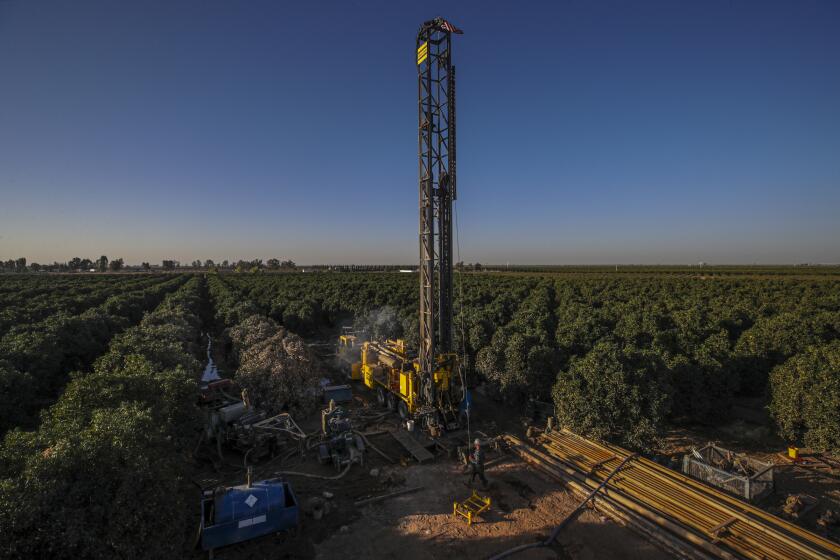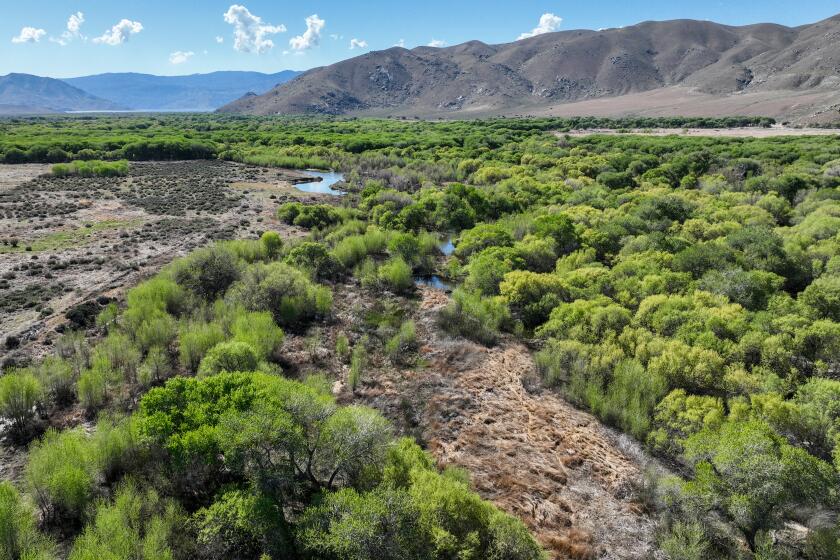A decade after signing of California groundwater law, major challenges remain

- Share via
In 2014, Gov. Jerry Brown signed historic legislation establishing a framework for California to begin managing groundwater in an effort to curb widespread overpumping, which had sent aquifer levels into rapid decline, left hundreds of wells dry, and caused the ground to sink in parts of the Central Valley.
The law was based on the idea that groundwater could best be managed at the local level, and it called for newly formed local agencies to gradually adopt measures to address chronic declines in groundwater levels. The legislation laid out an implementation timeline stretching more than a quarter-century, giving many areas until 2040 to address their depletion problems.
Today, experts and state officials say implementation of the Sustainable Groundwater Management Act, or SGMA, is unfolding largely as expected. But while California has made some preliminary progress toward safeguarding groundwater, the hardest tests loom ahead.
“This is a generational shift in water management in the state,” said Joaquin Esquivel, chair of the State Water Resources Control Board. “What we do in these next years is critical.”
Aggressive and impactful reporting on climate change, the environment, health and science.
The state has taken several foundational steps, including the creation of local agencies and the adoption of more than 100 local groundwater plans. The law has led to the collection of more groundwater data and nearly $1 billion in state funding, and has raised public awareness about how heavy pumping, particularly for agriculture, has depleted underground supplies.
However, water levels have continued to decline in many areas as pumping restrictions have yet to be fully imposed and as local agencies continue to issue permits for more high-capacity wells. Research has shown that parts of California have recently had some of the fastest-declining aquifer levels in the world. In some places, the land has been sinking as much as 1 foot per year.
According to state data, more than 5,000 wells have run dry in the last decade, and scientists warn that thousands more could be at risk unless stronger measures are put in place.
Achieving sustainability goals in groundwater basins deemed to be in “critical overdraft” will be particularly challenging and is expected to require allocation and pumping restrictions that will sharply reduce agricultural water use. Researchers project that large portions of the Central Valley’s irrigated cropland will need to be permanently left dry to comply with the restrictions.
“We have good momentum here, 10 years on,” Esquivel said. “But we also are starting to see the phase of implementation and the difficulty that that will pose.”
Groundwater depletion is worsening in many of the world’s farming regions. But a global study also found that some efforts are helping to boost aquifers.
Initial steps toward regulation, such as collecting water-use data, charging fees and imposing water allocations and mandatory reductions in pumping, have been contentious and in places have sparked lawsuits.
State Department of Water Resources officials have reviewed plans submitted by local agencies and approved many of them. But in six areas of the San Joaquin Valley, officials have declared the local groundwater plans inadequate, a step that allows the state water board to place an area on probationary status to compel them to take stronger measures.
After the board took its first vote to intervene in one area, the Tulare Lake subbasin, farmers sued in an effort to overturn that decision, arguing that the state is making demands that are unreasonable, damaging to the local economy and “overreaching” beyond the law’s requirements. That case in Kings County Superior Court has effectively placed the state’s determination on hold and paused a requirement that growers begin measuring and reporting how much water they pump.
When a judge last week temporarily blocked the state’s measures and called the water board’s actions nontransparent, Dusty Ference of the Kings County Farm Bureau said it was a major win for the area’s farmers and California agriculture.
“We agree as an industry that efforts need to be made to balance groundwater extractions and overdraft, but that all has to be done in a way that doesn’t decimate our industry and our community,” Ference said.
California water officials backed a bill to impose restrictions on where wells can be drilled, seeking to protect drinking water sources. Lawmakers rejected it.
The state’s approach to intervention, he said, would saddle growers with an estimated $10 million annually in pumping fees, and would bring rapid and “extreme” restrictions on water use. He said farmers hope the court will overturn the state’s decision, allowing the region to implement plans for sustainability in other ways that will support the economy.
State regulators disagreed with the judge’s preliminary ruling, saying the water board has clear authority to intervene.
“Under SGMA, local agencies are responsible for the sustainable management of their groundwater basins,” said Edward Ortiz, a spokesperson for the state water board. “However, state agencies — namely the Department of Water Resources and State Water Board — are responsible for ensuring local groundwater management achieves SGMA’s goals.”
State officials say the temporary freeze on state requirements affects only the Tulare Lake subbasin, and they are moving ahead with separate processes to consider probationary measures in other areas of the San Joaquin Valley.
Groundwater accounts for approximately 40% of the state’s total water supplies in an average year and can make up roughly 60% of supplies during droughts.
The last two wet winters have helped boost aquifer levels after years of pervasive declines. State water managers have also sought to promote efforts to capture stormwater to replenish aquifers.
In recent months, dry conditions have reemerged alongside extreme heat. As of this week, the U.S. Drought Monitor reported 71% of the state as abnormally dry or in moderate drought.
Esquivel said the law was intended to help California adapt to worsening droughts brought on by global warming.
“It’s climate change that brought us the Sustainable Groundwater Management Act to begin with,” Esquivel said. When the law was developed a decade ago, rural communities were dealing with hundreds of dry wells during the 2012-2016 drought.
The latest drought, from 2020 through 2022, set a record as California’s driest three-year period on record, and state data show more than 2,600 dry wells were reported during that time.
In the San Joaquin Valley, 1,800 families rely on state-funded water deliveries to fill household tanks. The list of those waiting for fixes has been growing.
The state has been providing assistance for low-income residents in rural communities that have run out of water, including paying for water deliveries to fill household tanks while people wait to have new wells drilled or to be connected to nearby water systems.
According to state agencies, about 95% of all groundwater pumping in California is now subject to a locally adopted sustainability plan.
“I’m absolutely confident we are going to be successful in achieving groundwater sustainability,” said Paul Gosselin, the Department of Water Resources’ deputy director of sustainable water management.
The state agency is responsible for reviewing annual reports from local agencies and determining whether they are taking adequate steps to avoid undesirable results, such as “significant and unreasonable” lowering of groundwater levels, degraded water quality, land subsidence, seawater intrusion or effects on surface water and ecosystems.
The Department of Water Resources’ staff is also preparing to give local agencies guidance on how to manage land subsidence and how to prevent levels of pumping that cause significant depletion of surface water, Gosselin said.
He and other state officials say major challenges for communities include protecting vulnerable wells during droughts and establishing “demand management” through mandatory reductions in pumping, which some areas have begun to do.
The state has started some programs intended to help, such as grants paid to growers who agree to limit pumping, and a program that aims to support “multibenefit land repurposing,” helping to convert fallow farmland to other uses, such as solar farms or habitat restoration areas.
Another challenge is coordination among various local water-managing agencies. In some areas, groundwater agencies have recently been splitting and forming new agencies, increasing the number of entities that must work together on a single local blueprint.
“My fervent hope is that that coordination is happening in the context of really moving the entire region forward, versus bifurcating into ever smaller jurisdictions that sort of solve the problem at the expense of their neighbor,” said Karla Nemeth, director of the Department of Water Resources. “They are solvable problems if we’re working together and if we’re communicating together.”
Hydrologist Melissa Rohde studies California ecosystems that depend on groundwater. In many areas, declining water levels put habitats at risk of drying up.
Speaking at a UC Davis conference ahead of the law’s 10th anniversary, Nemeth said the state is on track to manage groundwater sustainably, even though officials “don’t have all the answers” about what steps will ultimately be needed to achieve the law’s goals.
“I believe we are well positioned to address those challenges as they come,” Nemeth said. “There’s a whole lot of change that’s coming, particularly in our overdrafted areas, but what’s really important about it is in 2040 everybody who lives in those areas, their water supply will be more reliable than it is today.”
Advocates for rural communities that are dealing with dry wells or contaminated water supplies have urged state officials to prioritize measures to protect drinking water and limit overpumping.
“We can’t wait until 2040 to be in sustainability. We need to make sure we have demand management now,” said Tien Tran, a senior policy advocate for the group Community Water Center.
Tran pointed out that reviews of the first round of local plans found many wouldn’t adequately protect drinking water, small farmers or the environment. She said the fragmentation of agencies that should be working together is also a problem.
When a moderator asked her to give a letter grade for the law’s implementation so far, Tran said it’s been between a C-plus and a B-minus.
“There’s still so much infighting that’s happening because there’s not a culture of collaboration,” Tran said. “There’s a scarcity mindset where people are fighting over water.”
Toward a more sustainable California
Get Boiling Point, our newsletter exploring climate change, energy and the environment, and become part of the conversation — and the solution.
You may occasionally receive promotional content from the Los Angeles Times.












